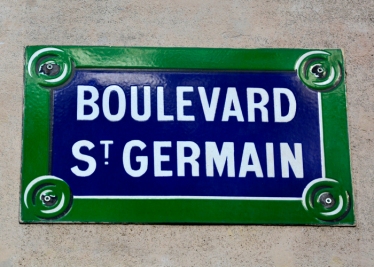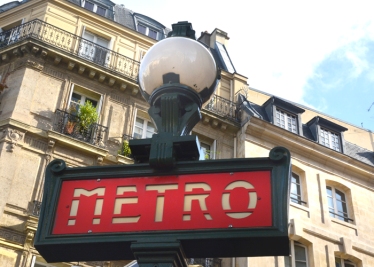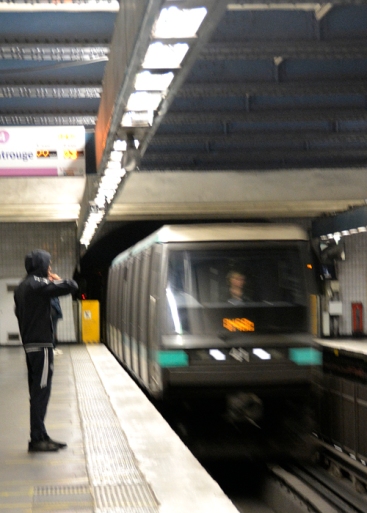Paris has a large, complex transport system, consisting of buses, a few trams, a huge metro, and a train system (“RER”). There’s even at least one funicular, which goes up a steep hill to Sacre Coeur. They all operate on the same ticket system, although for the train that’s true only in Paris (the trains go farther than Paris, and those require other tickets, or a pass. See below.)

Paris street signs ; small and on the side of buildings
There are many websites describing the system and how to use it, so I’m not going to cover much of that detail here. There are a few things they sort of gloss over, though, which puzzled us upon first attempt to use them.
The basic ticket is called a t+ ticket. It’s good for unlimited bus and tram travel for 90 minutes, and 2 hours on the train or metro. You can transfer all you want among buses and trams, and between metro lines and trains, but not between the two sets (surface and underground). Also, you can’t reverse direction on the bus, or use the same one twice.

A t+ ticket costs €1.90 (all details as of October 2017) from a machine or human in the metro station, or in a tabac. You should probably buy 10 (14.90), called a carnet. There are several passes, most of which are not cost-effective. The one that is a deal is called Navigo Decouverte, but it has some limitations. The card itself is €5, and a week’s pass is 22.80. The problem is that a “week” means Monday to Sunday, and you can’t even buy this week’s pass after Thursday; you’ll get next week’s pass instead if you try. But it’s sure a great deal if you arrive early in the week, and if you arrive at either airport up through Thursday it’s still a deal because it covers all 5 zones, including the RER outside of Paris. A ticket from the airport to town would otherwise cost 10.30. It’s 7.10 for a round trip to Versailles.
If you’re arriving at an airport, try to buy the pass there. Wherever you buy it, YOU NEED ONE PHOTO, nominally 3 by 2.5 cm, which is smaller than a US passport photo. There are photo booths around. You can bring your own, and it doesn’t have to be great quality or even in color, just to look like you. Scan your passport or driver license photo. At CDG airport, the office is in the train station level; look for “Billets Ile-de-France.” It’s modern, quiet, they speak English, no problem with your credit card, it’s wonderful. The nice lady activated our cards and handed them to us. You’re supposed to put the photo and your name on them before you use them, but even when we ran into ticket inspectors, they just checked the cards electronically, not for pictures.
The ticket machines in the stations speak five languages. They take credit cards, and usually they accept US chip-and-signature ones, at least for amounts as great as 22.80. When you use one, it will say “enter your PIN” — but if it’s a credit card without a PIN, just wait about 10 seconds and it will proceed anyway. The machines take coins, but not euro notes. There are change machines in some stations, but usually also a human if your card doesn’t work and you don’t have enough coins.
The reason a pass is preferable to tickets is convenience and flexibility. If you make a mistake and end up going the wrong direction, or on the wrong line, there’s no “OMG I’m out of tickets!”, you can just treat it as an adventure (“Oh honey, I meant to do that! We’re exploooooring!”). You can take random buses just to see where they go. You can take a bus three blocks when you’re just too pooped to walk without feeling that you’re wasting a ticket. And if it rains … well, you’ll be glad you’re prepared as far as transportation goes.
So, how to ride the bus. As I said, this is covered pretty well elsewhere. Find the stop (check which direction, it will say on the small route number sign up on a pole). The bus will show its destination as it approaches. Board at the front except on the long multi-section buses which permit boarding in the middle. If you have a pass, place it on the reader just inside the door. If you have a ticket, validate it in the machine behind the driver. Stick it in stripe down and wait for the beep, then take it out (“retirez”). The first time, try to watch someone else. If you’re transferring from another bus, validate the same ticket again.
You can buy a single use ticket from the driver. It’s €2.00 and not good for a transfer, though, so avoid having to do this.
Now, how to get into the metro. This is one of those “glossed over” details. If you have a pass, slap it on the purple spot on the gate. Within a second, it will beep (but you may not hear it!), and a dim green arrow may appear, or an LCD screen might say “passez.” Pick your pass back up. If you have a ticket, insert in in the front of the gate, and take it out when it appears again. Some of the gates in a row of gates only accept passes, not tickets.
NOW for the mystery: There are at least two kinds of gates. For the ones without turnstiles, after you get the go signal, you have to approach them, and they will open. If you don’t move forward, they won’t open, and will eventually time out. There is also a kind with turnstiles AND a tall gate. You have to charge through the turnstile AND push on the gate to go through it. This is risky if you have a camera, as it is likely to get bashed. It’s impossible with luggage. There is usually a single wider gate for use by the handicapped or those with luggage. At very large stations, there may be an attendant to help.
At this point, the metro is like most others. You need to know the line and direction, which is the name of the station at the far end. Signage is plentiful but sometimes what I call “New Jersey” style: too small, imprecise, and beyond where you actually need to turn. If you’ve ever driven on a highway in New Jersey, you’ll understand.
The metro is always well filled, but in rush hour it’s just nuts. We have waited for the next train more than once. They come every 2 minutes at this time of day. Look for the least dense part of the platform. It’s either the middle or the far end from where you entered, depending on how many entrances there are.
Before you exit, know which street exit you want. There’s a map, and a sign “Sortie” which will list them. They have numbers and names. This isn’t crucial, but if you choose the right one you’ll be in the right place headed in the right direction, and you’ll avoid looking like a lost tourist. There is a GREAT neighborhood map outside every Metro station exit, though.
To exit from most metro stations, there is just a metal gate you push on. If you’re exiting into a RER train station, and in a few other places, you’ll have to use your ticket or pass to get out.
By the way, the Metro is not very friendly to the handicapped. In most city stations, ONE exit will have an escalator (and the Sortie signs will indicate which) which goes up, but none that goes down, and no elevator/lift. There are lots of stairs within a station, down to the platforms, and there are almost never any assistance there.
Uber is present in Paris, but can’t pick you up at a train station or airport. The AUTHORIZED taxis are all regulated and there are taxi apps you can use. Outside train stations, you will find unregulated drivers offering to let you skip the line and go with them — only €35, monsieur, for a 5-minute ride!
That’s most of my “secret advice.” There’s a good general explanation here, and I recommend the website parisbytrain.com .